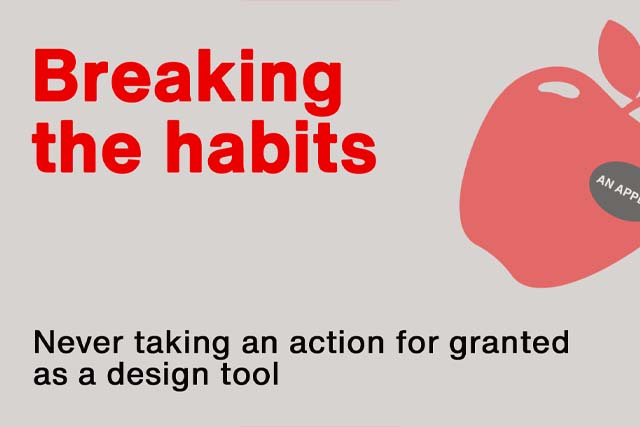
13 Oct Breaking the Habits
Never take an action for granted as a design tool
Have you ever noticed that when someone evaluates your design, they seem to enter a “design critique mode” and inevitably offer comments on what they observe at that moment? The comments often include phrases like:
“It’s not comfortable.” “It provides good lighting.” “It’s heavy.” …and so on.
This phenomenon occurs during events like fairs, exhibitions, product reviews, pitches, or any situation where someone has designed something that needs to be critiqued. Does the same behavior occur to objects when you visit your local bar or go to your nearest laundry? Almost never.

When we encounter something new, we tend to adopt an attitude that encourages us to explore and understand it. Because someone seeks our opinion, we suddenly feel like experts, compelled to say something even if we know little about the subject. If we can’t find anything specific to say, we resort to using generic criteria that we can understand at that moment.
For instance, we might comment on the comfort of a chair or the aesthetic appeal of a painting without delving into the context.
But why don’t we apply the same approach when we navigate our everyday lives?
The answer likely lies in our habits and our tendency to take certain situations for granted. The harsh fluorescent lighting in an office that strains our eyes and dampens our mood, the uncomfortable chairs at the local kebab shop, or the potholes in the street—these issues become routine, and over time, we become accustomed to them, accepting them as part of life.

Because we’ve grown accustomed to them, these issues often go unnoticed, which can be both a joy and a pain for designers. On one hand, discovering these overlooked problems when no one else does can be a wellspring of inspiration for a designer.
I’m one of those who have accepted these situations, but it’s precisely the kind of challenge a designer can tackle.
This attitude is not limited to individuals; it can also be observed in some companies. How many times have you heard the phrase, “We’ve always done it this way”? When something is functional, it’s challenging to envision how it could be improved, especially if it’s been done the same way for years.
In the realm of product design, which is often tied to established standards, breaking from the norm presents significant challenges. A table has four legs, a bookshelf consists of planes, and there are numerical rules governing design. Changing the game confronts two main obstacles: convincing a company to alter a function or construction and persuading users to change their habits.
Attempting to change habits and not taking anything for granted can be both inspiring and revolutionary. In the world of gift accessories, it’s easier to explore this concept because people are open to playful experimentation. However, for more serious matters, innovation that challenges established habits remains a formidable task.

A valuable exercise is to approach tasks as if no function has ever been explored before. I experimented with this concept while making a hammer, not because it was commissioned but out of personal curiosity. I placed myself in a primitive situation where I needed to drive a nail using whatever was at hand. At that time, I was working extensively with metal tubes, so I used one as my tool. I’m not suggesting that this is the definitive solution for designing a hammer, but it certainly differs from the conventional stick-and-heavy-head design. This trial might yield a solution, inspire a new approach, or turn out to be impractical, but it represents a new chapter in the narrative of the design world.

It’s akin to designing without instructions, and in some cases, it can spark the right inspiration for achieving a small but meaningful innovation.
For more articles surf the Journal section.


